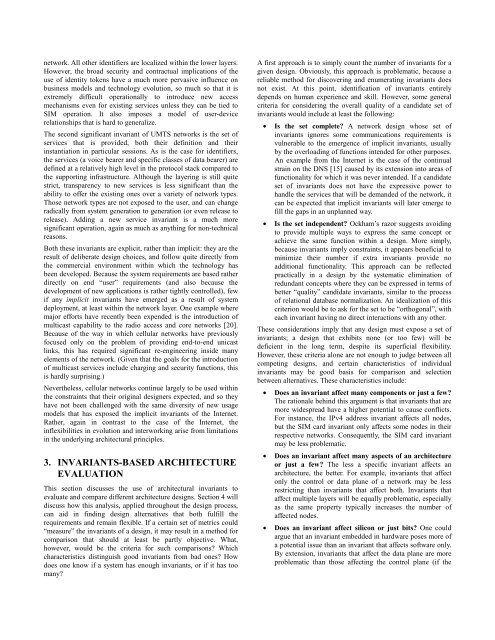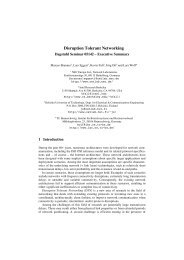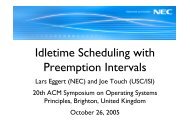A New Design Methodology for Network Architectures - Lars Eggert
A New Design Methodology for Network Architectures - Lars Eggert
A New Design Methodology for Network Architectures - Lars Eggert
Create successful ePaper yourself
Turn your PDF publications into a flip-book with our unique Google optimized e-Paper software.
network. All other identifiers are localized within the lower layers.<br />
However, the broad security and contractual implications of the<br />
use of identity tokens have a much more pervasive influence on<br />
business models and technology evolution, so much so that it is<br />
extremely difficult operationally to introduce new access<br />
mechanisms even <strong>for</strong> existing services unless they can be tied to<br />
SIM operation. It also imposes a model of user-device<br />
relationships that is hard to generalize.<br />
The second significant invariant of UMTS networks is the set of<br />
services that is provided, both their definition and their<br />
instantiation in particular sessions. As is the case <strong>for</strong> identifiers,<br />
the services (a voice bearer and specific classes of data bearer) are<br />
defined at a relatively high level in the protocol stack compared to<br />
the supporting infrastructure. Although the layering is still quite<br />
strict, transparency to new services is less significant than the<br />
ability to offer the existing ones over a variety of network types.<br />
Those network types are not exposed to the user, and can change<br />
radically from system generation to generation (or even release to<br />
release). Adding a new service invariant is a much more<br />
significant operation, again as much as anything <strong>for</strong> non-technical<br />
reasons.<br />
Both these invariants are explicit, rather than implicit: they are the<br />
result of deliberate design choices, and follow quite directly from<br />
the commercial environment within which the technology has<br />
been developed. Because the system requirements are based rather<br />
directly on end “user” requirements (and also because the<br />
development of new applications is rather tightly controlled), few<br />
if any implicit invariants have emerged as a result of system<br />
deployment, at least within the network layer. One example where<br />
major ef<strong>for</strong>ts have recently been expended is the introduction of<br />
multicast capability to the radio access and core networks [20].<br />
Because of the way in which cellular networks have previously<br />
focused only on the problem of providing end-to-end unicast<br />
links, this has required significant re-engineering inside many<br />
elements of the network. (Given that the goals <strong>for</strong> the introduction<br />
of multicast services include charging and security functions, this<br />
is hardly surprising.)<br />
Nevertheless, cellular networks continue largely to be used within<br />
the constraints that their original designers expected, and so they<br />
have not been challenged with the same diversity of new usage<br />
models that has exposed the implicit invariants of the Internet.<br />
Rather, again in contrast to the case of the Internet, the<br />
inflexibilities in evolution and interworking arise from limitations<br />
in the underlying architectural principles.<br />
3. INVARIANTS-BASED ARCHITECTURE<br />
EVALUATION<br />
This section discusses the use of architectural invariants to<br />
evaluate and compare different architecture designs. Section 4 will<br />
discuss how this analysis, applied throughout the design process,<br />
can aid in finding design alternatives that both fulfill the<br />
requirements and remain flexible. If a certain set of metrics could<br />
“measure” the invariants of a design, it may result in a method <strong>for</strong><br />
comparison that should at least be partly objective. What,<br />
however, would be the criteria <strong>for</strong> such comparisons? Which<br />
characteristics distinguish good invariants from bad ones? How<br />
does one know if a system has enough invariants, or if it has too<br />
many?<br />
A first approach is to simply count the number of invariants <strong>for</strong> a<br />
given design. Obviously, this approach is problematic, because a<br />
reliable method <strong>for</strong> discovering and enumerating invariants does<br />
not exist. At this point, identification of invariants entirely<br />
depends on human experience and skill. However, some general<br />
criteria <strong>for</strong> considering the overall quality of a candidate set of<br />
invariants would include at least the following:<br />
• Is the set complete? A network design whose set of<br />
invariants ignores some communications requirements is<br />
vulnerable to the emergence of implicit invariants, usually<br />
by the overloading of functions intended <strong>for</strong> other purposes.<br />
An example from the Internet is the case of the continual<br />
strain on the DNS [15] caused by its extension into areas of<br />
functionality <strong>for</strong> which it was never intended. If a candidate<br />
set of invariants does not have the expressive power to<br />
handle the services that will be demanded of the network, it<br />
can be expected that implicit invariants will later emerge to<br />
fill the gaps in an unplanned way.<br />
• Is the set independent? Ockham’s razor suggests avoiding<br />
to provide multiple ways to express the same concept or<br />
achieve the same function within a design. More simply,<br />
because invariants imply constraints, it appears beneficial to<br />
minimize their number if extra invariants provide no<br />
additional functionality. This approach can be reflected<br />
practically in a design by the systematic elimination of<br />
redundant concepts where they can be expressed in terms of<br />
better “quality” candidate invariants, similar to the process<br />
of relational database normalization. An idealization of this<br />
criterion would be to ask <strong>for</strong> the set to be “orthogonal”, with<br />
each invariant having no direct interactions with any other.<br />
These considerations imply that any design must expose a set of<br />
invariants; a design that exhibits none (or too few) will be<br />
deficient in the long term, despite its superficial flexibility.<br />
However, these criteria alone are not enough to judge between all<br />
competing designs, and certain characteristics of individual<br />
invariants may be good basis <strong>for</strong> comparison and selection<br />
between alternatives. These characteristics include:<br />
• Does an invariant affect many components or just a few?<br />
The rationale behind this argument is that invariants that are<br />
more widespread have a higher potential to cause conflicts.<br />
For instance, the IPv4 address invariant affects all nodes,<br />
but the SIM card invariant only affects some nodes in their<br />
respective networks. Consequently, the SIM card invariant<br />
may be less problematic.<br />
• Does an invariant affect many aspects of an architecture<br />
or just a few? The less a specific invariant affects an<br />
architecture, the better. For example, invariants that affect<br />
only the control or data plane of a network may be less<br />
restricting than invariants that affect both. Invariants that<br />
affect multiple layers will be equally problematic, especially<br />
as the same property typically increases the number of<br />
affected nodes.<br />
• Does an invariant affect silicon or just bits? One could<br />
argue that an invariant embedded in hardware poses more of<br />
a potential issue than an invariant that affects software only.<br />
By extension, invariants that affect the data plane are more<br />
problematic than those affecting the control plane (if the





